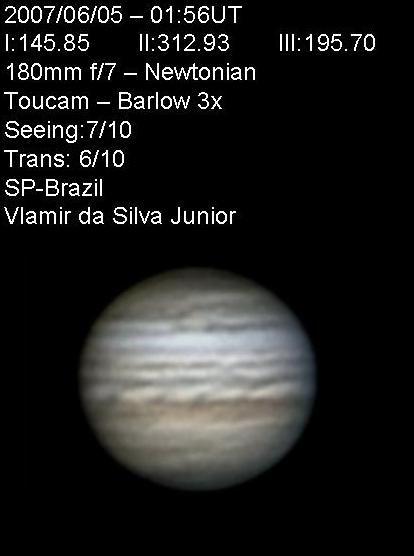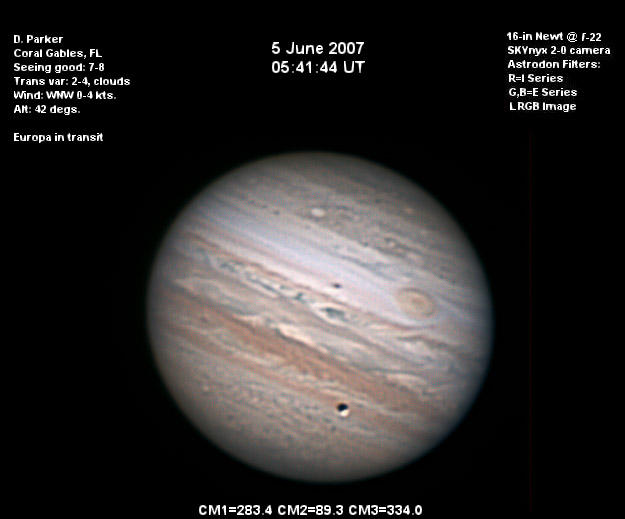木星 ALPO-Japan Latest

Jupiter Image 2007/06/05(UT)
熊森照明,柚木健吉
Vlamir da Silva Junior,Christopher Go,Donald C Parker,Hubble Space Telescope
V.da Silva Jr.,T.Kumamori,Christopher Go,Don,K.Yunoki,HST
|
Vlamir da Silva Junior (180mm Newtonian) |

[Vlamir da Silva Junior : Sao Paulo,Brazil]
|
Teruaki Kumamori (200mm Dall-kirkham) |
薄雲を通しての撮影です。この後、晴れそうだったのですが寝てしまいました。
 ≪大阪府堺市 熊森照明≫
≪大阪府堺市 熊森照明≫
|
Christopher Go (Celestron C11) |
Conditions were good this evening.
GRS is rising. The STB remnant is very prominent southwest of the GRS. Note the bright feature embedded in this remnant.
The SEBs has become veryh pale while the small red oval is getting darker. The SED is currently below the GRS.
The WOZ in the NEBn looks very disturbed. The dark spot west of looks really interesting and very 3D! The NTB has the same color as the NEB.


[Christopher Go : Cebu Philippines]
|
Donald C Parker(16-in (41cm) Newtonian) |



 [ Donald C Parker Coral Gables,Florida U.S.A]
[ Donald C Parker Coral Gables,Florida U.S.A]
|
Kenkichi.Yunoki (260mm Newtonian) |
当初、雲もあり透明度が悪く、モノクロ撮像をしたが、その後やや改善したためカラーに切り換えた。

[Kenkichi Yunoki (Sakai City Japan)]
≪大阪府 堺市 柚木健吉≫
|
Hubble Space Telescope(2900mm fl=5300mm) |
Massive Jupiter is undergoing dramatic atmospheric changes that have never been seen before with the keen "eye" of NASA's Hubble Space Telescope.
Jupiter's turbulent clouds are always changing as they encounter atmospheric disturbances while sweeping around the planet at hundreds of miles per hour. But these Hubble images reveal a rapid transformation in the shape and color of Jupiter's clouds near the equator, marking an entire face of the globe.
The planet is wrapped in bands of yellows, browns, and whites. These bands are produced by the atmosphere flowing in different directions at various latitudes. Lighter-hued areas where the atmosphere rises are called zones. Darker regions where the atmosphere falls are called belts. When these opposing flows interact, storms and turbulence appear.
Between March 25 and June 5, Hubble's Wide Field and Planetary Camera 2 captured entire bands of clouds changing color. Zones have darkened into belts and belts have lightened and transformed into zones. Cloud features have rapidly altered in shape and size.
The image at left shows a thin band of white clouds above Jupiter's equator. The white color indicates clouds at higher altitudes in Jupiter's atmosphere. In the image at right, the band's white hue has turned brown, showing clouds deep within the planet's atmosphere. The whole band appears to have merged with the one below it.
In the same cloud band above the equator, the small swirls in the left-hand image have morphed into larger wave-like features in the right-hand photo. Dominating the band is a dark streak that resembles a snake. This serpent-shaped structure is actually a small tear in the cloud deck, which gives astronomers a view deep within the atmosphere.
Below the equatorial region, the brownish upside-down shark fin in the left-hand image disappears in the photo at right. Appearing instead are brownish tongue-shaped clouds with a stream of white swirls below them.
These global upheavals have been seen before, but not with Hubble's sharp resolution. Astronomers using ground-based telescopes first spied drastic atmospheric transformation in the 1980s. Another major disturbance was seen in the early 1990s, after Hubble was launched into space. The telescope, however, did not have the resolution to view the upheaval in fine detail. These higher-quality Hubble images may help astronomers understand how such global upheavals develop on Jupiter.
For additional information, contact:
Donna Weaver/Ray Villard
Space Telescope Science Institute, Baltimore, Md.
410-338-4493/4514; dweaver@stsci.edu/villard@stsci.edu
Dr. Amy Simon-Miller
NASA Goddard Space Flight Center, Greenbelt, Md.
301-286-6738; amy.simon@nasa.gov
South up image

Original 527kB jpg

Original 1637kB tif
[NASA/JPL/Space Science Institute]



≪大阪府堺市 熊森照明≫





[ Donald C Parker Coral Gables,Florida U.S.A]



 ALPO-Japan Latest
ALPO-Japan Latest

 Jupiter Section
Jupiter Section